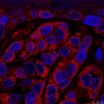(Press-News.org) Researchers from the Spanish National Cancer Research Centre (CNIO) have discovered more than 40 genes that predict the level of aggressiveness of melanoma and that distinguish it from other cancers with a poor prognosis. The discovery, published in Cancer Cell, will help to identify unique aspects of melanoma that could contribute to determine the risk of developing metastasis in patients with this disease. This study is relevant because it explains why a drug, also described by CNIO, is being used to selectively attack the melanoma tumour cells. Melanoma is one of the worst, most metastatic cancers known today.
What is the function of these genes? Strangely, the factors that are increased in melanoma share a common mechanism: the formation of vesicles called endosomes.
Endosomes are machinery that tumour cells, via a process called endocytosis, can use to incorporate components into their environment and obtain energy by degrading them via autodigestion or autophagy. Autophagy is also used for self-cleaning to eliminate other proteins as well as damaged or unneeded cellular components.
Among all the genes that control endocytosis, the authors of the study focused specifically on one, called RAB7; this gene is highly expressed in melanoma cells. After more than six years of research, the research team led by María Soengas, head of CNIO's Melanoma Group, showed that RAB7 acts as an orchestra director, determining the fate of melanoma cells: at high concentrations of RAB7, cellular autodigestion is very active, and this allows tumour cells to obtain energy, prevent the accumulation of toxic components and thus divide and proliferate; when RAB7 is reduced, cells use endosomes to recycle metastatic proteins, favouring their dispersal throughout the body.
Defining "the key to the fate of the tumour cell", as Soengas says, is just one of many new aspects of melanoma uncovered by this study. "Finding which mechanisms determine why melanoma is so aggressive is very complex because more than 80,000 mutations have been described for this tumour", says Direna-Alonso Curbelo, the article's first author.
POTENTIAL CLINICAL APPLICATIONS
This study is also relevant for clinical work. One application is the prognosis of the melanoma: the authors show in tumour biopsies that the amount of RAB7 in a cutaneous tumour defines the risk of developing metastasis. "This study opens avenues for the potential use of proteins that control vesicles and regulate autophagy as novel markers of patient survival", says Soengas.
Furthermore, these results help to understand the mechanism of action of a compound that, as the group discovered in 2009, is lethal in melanoma cells as well as in other tumour cells. This RNA-based nanoparticle compound kills the cells by acting on the formation of vesicles.
"We knew how our nanoparticles act inside tumour cells, but not how they selectively incorporate inside the cells", says Soengas. The size of these molecules requires cells to form endosomes in order to be able to trap the compound. This study demonstrates that this endosome formation (via RAB7) is very active in tumour cells but not in normal cells. Normal cells, therefore, do not incorporate RNA nanoparticles, reducing the risk of toxic effects.
The work published in Cancer Cell complements previous research efforts from the CNIO Melanoma Group, which could lead to the development of novel drugs that selectively target the mechanism of cell autodigestion as a potential therapeutic strategy.
MULTIDISCIPLINARY APPROACH
This has been a multidisciplinary study in which many new computational techniques have been used to process large amounts of genomic data. CNIO's Bioinformatics Unit has been key in comparing 900 cell lines derived from up to 35 tumour types in order to identify unique aspects of melanoma. On the other hand, CNIO's Molecular Imaging Unit has made it possible to analyse vesicle formation mechanisms at high resolution and in real-time.
The study's authors have worked alongside researchers from the Memorial Sloan Kettering Cancer Center in New York, as well as with dermatologists and pathologists from the hospital 12 de Octubre in Madrid, and experts in the field of melanoma diagnosis and treatment.
This work has been funded by the Ministry of Economy and Competitiveness, the National Institute of Health Carlos III, the Melanoma Research Foundation, the American Cancer Society, the Fundación Mutua Madrileña and the Fundación "La Caixa".
INFORMATION:
Reference article:
Alonso-Curbelo et al., RAB7 Controls Melanoma Progression by Exploiting a Lineage-Specific Wiring of the Endo- lysosomal Pathway, Cancer Cell (2014), http://dx.doi.org/10.1016/j.ccr.2014.04.030
CNIO researchers discover more than 40 melanoma-specific genes that determine aggressiveness
The results of the study could help to determine the development of metastasis in patients suffering from the disease
2014-06-27
ELSE PRESS RELEASES FROM THIS DATE:
NIH scientists establish proof-of-concept for host-directed tuberculosis therapy
2014-06-27
WHAT:
In a new study published in Nature, scientists describe a new type of tuberculosis (TB) treatment that involves manipulating the body's response to TB bacteria rather than targeting the bacteria themselves, a concept called host-directed therapy. TB remains a major cause of disability and death worldwide as an estimated 8.6 million people fell ill with TB and 1.3 million people died from the disease in 2012, according to the World Health Organization. Although TB is curable, adherence to therapy is difficult as treatment requires taking antibiotic drugs for at least ...
Walking the rocks: GSA Today article studies undergraduate field education
2014-06-27
Boulder, Colorado, USA – In the July 2014 issue of GSA Today, Heather Petcovic of Western Michigan University and colleagues Alison Stokes and Joshua Caulkins examine the question of geoscientists' perceptions of the value of undergraduate field education. Despite being perceived as integral to both geoscience learning and professional preparation, little research exists on the types of field experiences that carry the most value.
In their study, Petcovic and colleagues compile and analyze survey data obtained during two Geological Society of America (GSA) annual meetings ...
Research provides new theory on cause of ice age 2.6 million years ago
2014-06-27
New research published today (Friday 27th June 2014) in the journal Nature Scientific Reports has provided a major new theory on the cause of the ice age that covered large parts of the Northern Hemisphere 2.6 million years ago.
The study, co-authored by Dr Thomas Stevens, from the Department of Geography at Royal Holloway, University of London, found a previously unknown mechanism by which the joining of North and South America changed the salinity of the Pacific Ocean and caused major ice sheet growth across the Northern Hemisphere.
The change in salinity encouraged ...
Scientists identify new pathogenic and protective microbes associated with severe diarrhea
2014-06-27
In a finding that may one day help control a major cause of death among children in developing countries, a team of researchers led by faculty from the University of Maryland, College Park and the University of Maryland School of Medicine has identified microorganisms that may trigger diarrheal disease and others that may protect against it. These microbes were not widely linked to the condition previously.
"We were able to identify interactions between microbiota that were not previously observed, and we think that some of those interactions may actually help prevent ...
Genetics dominant risk factor in common cancers
2014-06-27
A study of individuals who have been adopted has identified genetics as the dominant risk factor in 'familial' breast, prostate and colorectal cancers.
Researchers at the Centre for Primary Health Care Research at Lund University and Region Skåne in Sweden have presented the new research findings based on studies of population registers.
"The results of our study do not mean that an individual's lifestyle is not important for the individual's risk of developing cancer, but it suggests that the risk for the three most common types of cancer is dependent to a greater ...
Social pressure stops Facebook users recommending products on social media sites
2014-06-27
Facebook has more than 1.23 billion active users worldwide, with over 50 per cent of all users logging on to it on any given day. Most of Facebook's revenue comes from advertising and the company is looking at ways to make the site a more effective advertising platform for marketers. This includes selling ads that are more targeted to their users.
However, researchers have found that users of social media websites are less likely to use them to say positive things about their favourite products and services. Instead, they are more likely to express their opinions about ...
Scientists identify new pathogenic & protective microbes associated with severe diarrhea
2014-06-27
In a finding that may one day help control a major cause of death among children in developing countries, a team of researchers led by faculty from the University of Maryland, College Park and the University of Maryland School of Medicine has identified microorganisms that may trigger diarrheal disease and others that may protect against it. These microbes were not widely linked to the condition previously.
"We were able to identify interactions between microbiota that were not previously observed, and we think that some of those interactions may actually help prevent ...
Eco-friendly versatile nanocapsules developed
2014-06-26
The Institute for Basic Science (IBS) has announced that the Center for Self-assembly and Complexity have succeeded in developing a new technology that introduces metal nanoparticles on the surface of polymer nanocapsules made of cucurbit[6]uril.
The researchers have found that using polymer nanocapsules made of cucurbit[6]uril and metal salts can serve as a versatile platform where equal sized metal nanoparticles can be evenly distributed on the surface of the polymer nanocapsules. Cucurbit[6]uril has properties which strongly and selectively recognize organic and inorganic ...
Do people with autism struggle with driving?
2014-06-26
PHILADELPHIA (June 26, 2014)— In the first pilot study asking adults on the autism spectrum about their experiences with driving, researchers at Drexel University found significant differences in self-reported driving behaviors and perceptions of driving ability in comparison to non-autistic adults. As the population of adults with autism continues growing rapidly, the survey provides a first step toward identifying whether this population has unmet needs for educational supports to empower safe driving – a key element of independent functioning in many people's lives.
"Previous ...
Scientists find potential new use for cancer drug in gene therapy for blood disorders
2014-06-26
LA JOLLA, CA – June 26, 2014 – Scientists working to make gene therapy a reality have solved a major hurdle: how to bypass a blood stem cell's natural defenses and efficiently insert disease-fighting genes into the cell's genome.
In a new study led by Associate Professor Bruce Torbett at The Scripps Research Institute (TSRI), a team of researchers report that the drug rapamycin, which is commonly used to slow cancer growth and prevent organ rejection, enables delivery of a therapeutic dose of genes to blood stem cells while preserving stem cell function.
These findings, ...
LAST 30 PRESS RELEASES:
Strategic river sensors could have forewarned of Texas Camp flood disaster
Drone sampling of whale breath reveals first evidence of potentially deadly virus in Arctic
Roman soldiers defending Hadrian’s Wall infected by parasites, study finds
Pinochet’s prisoners were tormented with music but still found solace in it, a new book reveals
Fertility remains high in rural Tanzania despite access to family planning
AI-assisted device can improve autism care access
Kinetic careers
Uncovering how parasitic plants avoid attacking themselves to improve crop resistance
Nanoparticle vaccine strategy could protect against Ebola and other deadly filoviruses
Study finds brain care score can predict risk of stroke across racial groups
Key lung immune cells can intensify allergic reactions
Do hormones explain why women experience more gut pain?
New materials conduct ions in solids as easily as in liquids
Breakthrough of the Year: Renewable energy begins to eclipse fossil fuel-based sources
LLM use is reshaping scientific enterprise by increasing output, reducing quality and more
Introducing LightGen, a chip for ultra-fast, ultra-efficient generative AI
Astronomers see fireworks from violent collisions around nearby star
ACC/AHA issue new guideline on managing congenital heart disease in adults
Cosmic crash caught on camera
Is talented youth nurtured the wrong way? New study shows: top performers develop differently than assumed
Ants: An untapped resource in the development of antibiotics?
Archaeologists use AI to create prehistoric video game
Mitochondria migrate toward the cell membrane in response to high glucose levels
Tiny viral switch offers hope against drug-resistant bacteria
Most parents aware of early peanut introduction guidelines, but confused about details
HPV vaccine can protect against severe lesions of the vulva and vagina
Virtual care provision and emergency department use among children and youth
Quadrivalent HPV vaccine and high-grade vulvovaginal lesions
Insights into dry eyes gained from stem cell-derived tear glands
Researchers identify 166 human pluripotent stem cell lines available for use in clinical applications
[Press-News.org] CNIO researchers discover more than 40 melanoma-specific genes that determine aggressivenessThe results of the study could help to determine the development of metastasis in patients suffering from the disease




